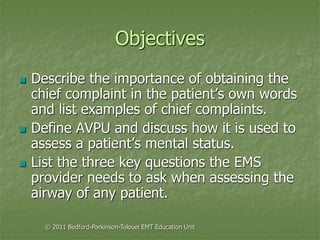Principles of assessment for ems chapter 04
- 1. Principles of Patient Assessment in EMS
- 2. Chapter 4 ŌĆō The Initial Assessment ┬® 2011 Bedford-Parkinson-Tolouei EMT Education Unit
- 3. Objectives ’ü« Describe the importance of obtaining the chief complaint in the patientŌĆÖs own words and list examples of chief complaints. ’ü« Define AVPU and discuss how it is used to assess a patientŌĆÖs mental status. ’ü« List the three key questions the EMS provider needs to ask when assessing the airway of any patient. ┬® 2011 Bedford-Parkinson-Tolouei EMT Education Unit
- 4. Objectives (continued) ’ü« Describe how to assess a patientŌĆÖs breathing. ’ü« List three key questions the EMS provider must keep in mind when assessing circulatory status. ’ü« Describe how to assess a patientŌĆÖs skin and list several abnormal skin conditions. ’ü« Describe the last step of the initial assessment and how it is used to make a transportation decision. ┬® 2011 Bedford-Parkinson-Tolouei EMT Education Unit
- 5. Introduction ’ü« Purpose is to rapidly identify and manage the life-threats. ’ü« Every patient should receive an initial assessment. ’ü« Treat any life-threats immediately. ’ü« Most patients do not have life-threatening problems. ┬® 2011 Bedford-Parkinson-Tolouei EMT Education Unit
- 6. Your General Impression ’ü« The environment (ie: bottom of stairs, out in the cold, tripod position, pool of blood) ’ü« PatientŌĆÖs MOI/NOI ’ü« PatientŌĆÖs age and sex ’ü« PatientŌĆÖs degree of distress ’ü« Listen for the chief complaint ’ü« Keep the priority of care in focus ┬® 2011 Bedford-Parkinson-Tolouei EMT Education Unit
- 7. Mental Status ’ü« Are they conscious or unconscious? (if unconscious do CPR quick-check) ’ü« Introduce yourself ’ü« WhatŌĆÖs your name? (oriented to person) ’ü« Do you know where you are? (oriented to place) ’ü« What day of the week is it? (oriented to day) ’ü« How can I help you today? (chief complaint) ┬® 2011 Bedford-Parkinson-Tolouei EMT Education Unit
- 8. A V P U ’ü« Alert ŌĆō oriented to person, place, and day (ŌĆ£big threeŌĆØ) ’ü« Verbal ŌĆō cannot answer the ŌĆ£big threeŌĆØ correctly ’ü« Painful ŌĆō either appropriate, inappropriate, or posturing (decorticate/decerebrate) ’ü« Unresponsive ┬® 2011 Bedford-Parkinson-Tolouei EMT Education Unit
- 9. Airway Status ’ü« The 3 key questions: ’ü« Is the airway open? ’ü« Will the airway stay open? ’ü« Does anything endanger the airway? ┬® 2011 Bedford-Parkinson-Tolouei EMT Education Unit
- 10. Airway Status ’ü« Factors to consider: ’ü« Unconsciousness ’ü« Suspected spinal injury ’ü« Obstruction ┬® 2011 Bedford-Parkinson-Tolouei EMT Education Unit
- 11. Airway Status ’ü« Complex airway problems: ’ü« Impaled object(s) ’ü« Significant MOI (i.e.: gunshot) ’ü« Burns ’ü« Crushed or fractured larynx ┬® 2011 Bedford-Parkinson-Tolouei EMT Education Unit
- 12. Breathing ’ü« The 6 key questions: ’ü« Is the patient breathing? ’ü« WhatŌĆÖs the respiratory rate? ’ü« Is the rate adequate? ’ü« Does anything endanger breathing? ’ü« Can the patient take a deep breath? ’ü« Is the patient having trouble breathing? ┬® 2011 Bedford-Parkinson-Tolouei EMT Education Unit
- 13. Breathing ’ü« Adequacy ’ü« Dyspnea ’ü« Chest wall stability ┬® 2011 Bedford-Parkinson-Tolouei EMT Education Unit
- 14. Circulatory Status ’ü« Ask the 3 key questions: ’ü« Does the patient have a pulse? ’ü« What is the quality of the pulse? ’ü« Is there any major bleeding that needs to be controlled? ┬® 2011 Bedford-Parkinson-Tolouei EMT Education Unit
- 15. Assess the Pulse ’ü« Distal vs. proximal ’ü« Infant and child pulses ’ü« External hemorrhage ’ü« Skin signs (CTC): ’ü« Color ’ü« Temperature ’ü« Condition ’ü« Capillary refill (in children) ┬® 2011 Bedford-Parkinson-Tolouei EMT Education Unit
- 16. Make a Priority Decision! ’ü« High or low priority ’ü« Transportation decision ’ü« Is ALS needed (consider an intercept) ┬® 2011 Bedford-Parkinson-Tolouei EMT Education Unit
- 17. Conclusion ’ü« Quickly assess for life-threats! ’ü« Remember the key steps of the initial assessment (MS-ABC). ’ü« Make a priority and transport decision! ┬® 2011 Bedford-Parkinson-Tolouei EMT Education Unit

















